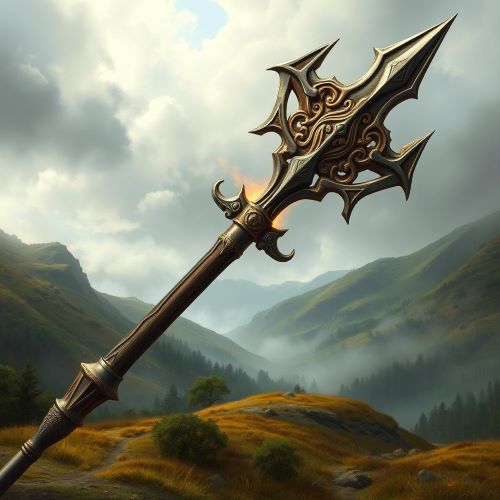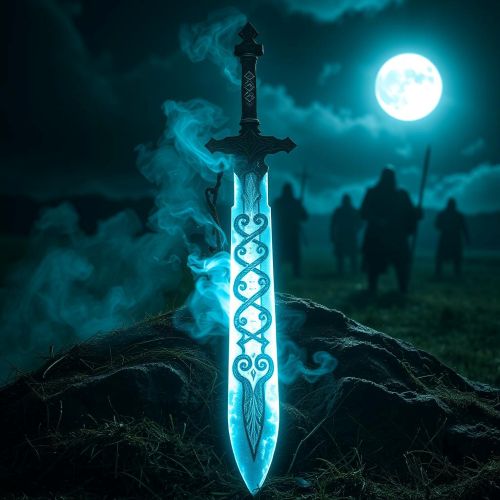Nifo Oti : The Tooth of Death
Nifu Oti
Introduction
The Nifo Oti, often translated as the “tooth of death” or more accurately as the “cutting tooth,” is one of the most emblematic symbols in Samoan cultural heritage. Recognized not only as a formidable weapon but also as a representation of warrior spirit, identity, and ceremonial prestige, the Nifo Oti occupies a unique place in the Pacific island’s mythology and history. Featuring a curved, toothed design with an imposing hook, it stands as both a masterpiece of craftsmanship and a vessel of mythic power. Today, its role stretches beyond the battlefield into the world of dance, cultural ceremony, and modern performance, keeping its legacy alive for future generations.
Origins
The creation of the Nifo Oti is deeply embedded in the fabric of Samoan legend and historical resistance. It is said to have been developed during a time of great conflict, when the Samoan people were fighting to reclaim their land and sovereignty from Tongan invaders. According to oral traditions, twin brothers Tunu and Fata, revered heroes in Samoan folklore, designed and wielded the first Nifo Oti to liberate their people—an act that not only symbolized tactical brilliance but also the spiritual will to remain autonomous.
Materially, the earliest versions of the Nifo Oti were fashioned from hardwood and enhanced with organic elements such as shark teeth or boar tusks. Later iterations saw the inclusion of European metals, especially after contact with Western explorers introduced steel tools resembling hooked agricultural implements. Samoans reimagined these utilitarian tools into deadly weapons, giving the Nifo Oti its iconic fusion of indigenous intent and external influence. The result was a distinctive weapon that honored its ancestral roots while adapting to new challenges.
Think you know your myths and legends? Dive into the world of ancient stories and test your knowledge with our engaging quizzes on Mythlok!
Powers
Although physically formidable, the Nifo Oti’s true power lies in what it represents. Its curved shape and hooked blade were perfect for parrying, disarming, and delivering precise strikes in close combat. The toothed edge was not merely decorative; it allowed warriors to trap and tear through enemy defenses with terrifying effectiveness. In skilled hands, it could neutralize opponents quickly, making it both a practical and psychological weapon of war.
Yet in traditional Samoan belief, the Nifo Oti was more than a weapon—it was a spiritual object. Warriors believed that ancestral mana, or spiritual energy, could be channeled through the blade, particularly in moments of dire need. Some tales describe the weapon as possessing a consciousness of its own, refusing to be wielded by those deemed unworthy. In dances and ceremonies, its presence signified strength, vigilance, and a connection to one’s forebears, ensuring that the past was never far from the present.
Owners/Users
Many figures in Samoan myth and history are linked to the Nifo Oti. Tunu and Fata, the legendary warrior twins, are perhaps the most famous, credited with designing the original form of the weapon and using it to drive out the Tongan king Talakaifaiki. Their stories are told across generations, their legacy encoded in chants, dances, and ceremonial tales.
Though not always depicted with the Nifo Oti in hand, the warrior goddess Nafanua is often associated with the same ethos that the weapon embodies—righteous combat, protection of the land, and divine justice. Her story reinforces the idea that the Nifo Oti is not solely a man’s weapon but a symbol of resistance and heroism open to all who seek justice.
In historical contexts, the weapon became a badge of honor among high-ranking chiefs and warriors, some of whom carried ornately carved Nifo Otis during peacetime as marks of their authority. The weapon often passed from generation to generation, carrying with it the accumulated mana of its lineage.
Instances used
Perhaps the most famous account of the Nifo Oti’s use in warfare is the battle that expelled the Tongan rulers from Samoan shores. As the story goes, Samoan warriors cleverly hid their weapons in sand before lulling the enemy into a false sense of security with festivities. When night fell, they retrieved the Nifo Otis, setting them ablaze and launching a surprise attack that ended the occupation. The distinctive hooked end of the weapon was even used to display the heads of defeated enemies—a grim but potent symbol of victory and deterrence.
With the eventual decline of tribal warfare, the Nifo Oti found new life in ceremonial practices. In dances like the ailao, it evolved from a weapon into a performance tool that showcased a warrior’s control, dexterity, and spiritual strength. These ritualistic dances were initially performed before battle to psych up the warrior spirit, but they gradually transitioned into peacetime celebrations that honored tradition and heritage.
Frequently Asked Questions
Lorem ipsum dolor sit amet, consectetur adipiscing?
Lorem ipsum dolor sit amet, consectetur adipiscing elit. Praesent convallis vestibulum justo, ac tincidunt nunc vehicula quis. Nullam id dolor quis orci malesuada feugiat. Curabitur aliquet libero at urna ullamcorper, ac ultricies nulla dapibus.
Lorem ipsum dolor sit amet, consectetur adipiscing?
Lorem ipsum dolor sit amet, consectetur adipiscing elit. Praesent convallis vestibulum justo, ac tincidunt nunc vehicula quis. Nullam id dolor quis orci malesuada feugiat. Curabitur aliquet libero at urna ullamcorper, ac ultricies nulla dapibus.
Lorem ipsum dolor sit amet, consectetur adipiscing?
Lorem ipsum dolor sit amet, consectetur adipiscing elit. Praesent convallis vestibulum justo, ac tincidunt nunc vehicula quis. Nullam id dolor quis orci malesuada feugiat. Curabitur aliquet libero at urna ullamcorper, ac ultricies nulla dapibus.
Lorem ipsum dolor sit amet, consectetur adipiscing?
Lorem ipsum dolor sit amet, consectetur adipiscing elit. Praesent convallis vestibulum justo, ac tincidunt nunc vehicula quis. Nullam id dolor quis orci malesuada feugiat. Curabitur aliquet libero at urna ullamcorper, ac ultricies nulla dapibus.
Lorem ipsum dolor sit amet, consectetur adipiscing?
Lorem ipsum dolor sit amet, consectetur adipiscing elit. Praesent convallis vestibulum justo, ac tincidunt nunc vehicula quis. Nullam id dolor quis orci malesuada feugiat. Curabitur aliquet libero at urna ullamcorper, ac ultricies nulla dapibus.
Watch
Source
Anonymous. (n.d.). The Nifo Oti. [Blog post]. Retrieved from https://timbtufuga.wordpress.com/2011/12/10/the-nifo-oti-the-samoan-kukri-by-tim-tufuga/
BlueInk Review. (2016, February 2). The Fire Knife Dance: The Story Behind the Flames Ta’alolo to Nifo’oti. Retrieved from https://www.blueinkreview.com/book-reviews/the-fire-knife-dance/
Encyclopedia MDPI. (2022, October 31). Fire Knife. Retrieved from https://encyclopedia.pub/entry/31972
Measina Samoa. (2025, February 8). From Warriors to Performers: The Evolution of Siva Afi. Retrieved from https://measinasamoa.com.au/blogs/news/from-warriors-to-performers-the-evolution-of-siva-afi
Old Lāhainā Lū’au. (2022, April 12). The Samoan Fire Knife Dance. Retrieved from https://oldlahainaluau.com/samoan-fire-knife-dance/
Oxford University Museum of Natural History. (2010, November 26). Steel nifo’oti (1928.59.21). Oceania Collection. Retrieved from https://web.prm.ox.ac.uk/weapons/index.php/tour-by-region/oceania/oceania/arms-and-armour-oceania-218/index.html
Polynesian Cultural Center. (n.d.). Fireknife Dance. Retrieved from https://worldfireknife.com/fireknife-dance/
Samoan Nifo Oti | Cultural Refresh — thecoconet.tv. (n.d.). Retrieved from https://www.thecoconet.tv/coco-learning/pacific-learning-talanoa/samoan-nifo-oti-cultural-refresh/
Taema: the Twins – Samoan Mythology. (2019, July 1). Retrieved from https://samoanmythology.net/ta-taema/








